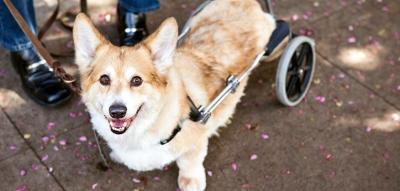
FAQs About Dog Wheelchairs
Dog wheelchairs and carts can be a huge help for canines with mobility issues. They can allow those dogs to get exercise and play — and simply have more freedom to move around. Here's what you need to know about dog wheelchairs.
What is a dog wheelchair or cart?
It’s a device that provides support for walking to assist dogs who have mobility issues. With dog wheelchairs, these dogs can play, run, and get the exercise they need.
What type of mobility issues are aided by dog carts?
Dog carts can help dogs with hip dysplasia, paralysis, arthritis, soreness, neurological issues, surgery recovery, spinal problems, amputations, and general weakness in the limbs. The need for a cart depends upon the nature of the dog’s disorder and the severity of the disability.
Who determines whether a dog needs a wheelchair?
You should work with a veterinarian to determine whether a dog wheelchair would be beneficial to your pup. In some cases, a vet might advise against using a wheelchair, so the dog can build muscle and gain strength on their own.
Are there different types of dog wheelchairs and support tools?
Dog wheelchairs and carts come in various shapes and styles to help with particular disabilities:
- Two-wheeled carts can be helpful for dogs with rear limb weakness or for post-surgery rehabilitation.
- Two-wheeled carts with extra support have a front extension that gives support to the front limbs.
- Some dog carts provide support for all four limbs. These are used when dogs are unable to walk with their front legs and must be supported in both the front and rear.
- Different wheel types are used on the carts, depending on the terrain or soil type where it will be used.
- Hand-held lifting devices, designed for pets with rear limb weakness, are used to help lift a dog up stairs, into the car, or through doorways.
- Walking aids, such as fabric harnesses and slings, can help to support a dog’s hindquarters.
How long will it take for my dog to get used to the cart?
Most dogs relish the freedom that a cart provides, so it usually takes only a few days for a dog to adjust. In some cases, it takes a bit longer, and some training might be necessary to help your dog adjust. Because of age or personality, a small percentage of dogs will reject a cart.
Home starts with you
Can I leave my dog unattended in a wheelchair?
A dog should never be left unattended while in a dog wheelchair. There’s a chance that the cart will become stuck or tip over.
Can a dog lie down in a dog wheelchair?
Smaller, short-legged dogs might be able to lie down while in a dog wheelchair; larger dogs cannot do so and must be removed from the wheelchair.
Will my dog be able to urinate and defecate while in the cart?
Yes, dog wheelchairs are designed to allow a dog to both urinate and defecate while in them.
Can a dog go up or down stairs while in a wheelchair?
If your dog has hind leg issues, you can help your dog go up or down a short flight of stairs by lifting the bar in the back of the cart and letting your dog use their front legs to take the steps.
How long can you leave a dog in a wheelchair?
Dog wheelchairs are not meant to be used for long periods of time or without supervision. If a dog has been given enough exercise while in the cart, they're usually ready to get out of the cart and relax.
Will special arrangements be needed for care when I’m not home?
It depends on the needs of your particular dog. Most dogs are content to sleep during the day if their people are gone. But daytime care might be necessary if your dog needs to be taken out to eliminate during the day or if your dog is incontinent. If doggy diapers are used, they should be changed regularly, so arrangements will need to be made for that to happen.
How beneficial is exercise for a dog with mobility issues?
Exercise is important to keep a dog in good physical condition. It’s also important to keep the dog’s weight down. The working limbs must remain strong and healthy. Dogs who begin to show behavior such as excessive barking, whining, or restlessness during the night usually do so out of boredom and lack of exercise. These behaviors typically diminish when the dog is regularly exercised with the aid of the cart. Also, exercise can help stimulate sluggish bowels to keep the pet more “on schedule.”
If a dog has some use of their rear legs, will using a cart discourage them from using those legs?
Pets who have limited use of their rear legs benefit from using a wheelchair because it enables them to exercise more intensely and for a longer duration of time.
Can a dog in a cart play with other dogs and family pets?
Because it’s something new, other pets might be fearful or startled at first by the sight of a dog in a wheelchair. Familiarize other pets with the cart in the same way that you would ordinarily introduce new pets. Keep all the animals safe by supervising the introductions and observing their body language carefully for signs of discomfort or stress. Once the other animals are comfortable around the dog in the cart, they can enjoy supervised interaction.
